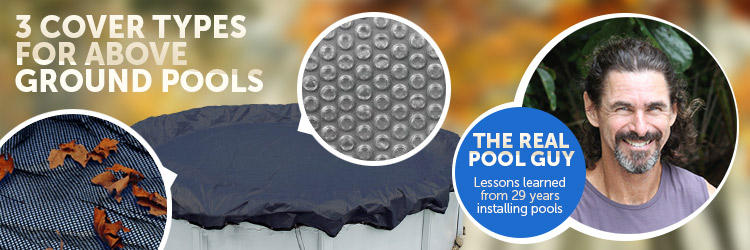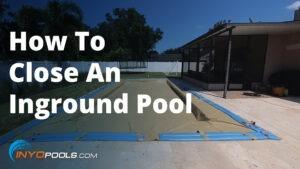Wanting to know about above ground pool covers? Well, there are three basic different types to choose from. Most of them are fairly inexpensive so if you have more money than time and don’t want to read about them, then get all three. If not, read on. I’ll tell you about all three so you can make an informed choice. I’ve got you covered (yea, that is a pun.)
Solid Covers for Above Ground Pools (Also Known as Winter Covers)
The solid pool cover is by far the most common cover out there. They are the most versatile and are used to winterize pools. Solid covers are given this name, because they are made out of waterproof material. Solid pool covers are bigger than your above ground pool’s dimensions to ensure you can cover the entire pool and have plenty of overlap which will cover the top seats and the outside of the pool. Most come with a cable that loop through the eyelets that are found along the edge. A winch is used to tighten the cable to secure the cover to the outside of the pool wall. This will discourage small animals from getting in the pool and high winds from blowing off the cover. Now before you say, “That’s the one I need,” this type of cover has one negative.
Taking off a Solid Pool Cover Can Suck
OK, so solid covers are great because they don’t let anything get through. However, that means every little twig or leaf or empty beer can from Uncle Jimmy will collect on top of that solid pool cover. Also, every time it rains the rainwater will collect on top of the cover. Water is heavy so when it’s time to take the cover off to go swimming, it can be a pain. Now if you live in an are a like San Diego where there’s not much rainfall, you do not have trees in your yard, and you do not have drunk relatives, a solid pool cover is cool. You’ll be able to remove your solid cover easily, because not much would have collected on top of it.
a like San Diego where there’s not much rainfall, you do not have trees in your yard, and you do not have drunk relatives, a solid pool cover is cool. You’ll be able to remove your solid cover easily, because not much would have collected on top of it.
For those not living in San Diego and who maybe have some trees, a solid pool cover may not be the best choice. For you in heavy rainfall areas, look into getting a good Cover Pump to remove standing water.
Consider Getting a Mesh Cover – You May Use It More
Most people here in Florida (that’s where I live) will use their solid pool cover only once or twice and then retire the unsightly blob that is not foldable to their shed or under their pool deck never to be used again. Why? Because it can suck that much to remove a solid pool cover. Now if you winterize, have a solid cover for that. But, if you get a lot of natural debris falling in your pool and it rains a lot where you live, consider using a mesh cover instead.
Mesh covers are more like nets that cover your pool’s surface. Just like solid covers, they are also bigger than the pool’s dimensions and have drawstrings to secure it in the same way. The big difference is that the mesh material is not impervious to rainwater and really traps only larger debris like leaves and sticks and beer cans. If you have a lot of trees, you’ll find yourself using it more than the solid one you first bought. The reason is that it is WAY EASIER to remove and cover the pool again. And it works pretty good in keeping the pool clear of all those falling leaves. So, if you actually want to use something that you buy, consider a mesh cover for your pool.
Solar Covers Will in No Way Heat the Pool’s Water
Yea, I know the above statement is a little off-topic, but everyone (including those of you blog post skimmers who only read the headlines) has to read this. I cannot tell you how many people over the years have told me that they expected their solar pool cover to have heated the pool’s water. So to be clear, there is only one reason to get a solar cover for your above ground swimming pool and that’s to help retain whatever heat that is already in the water. Usually you would only have a solar cover if your pool has some type of pool heater attached. The water gets heated by said heater and then you place a solar cover on the body of water to retain the heat. There are some who use a solar cover later in the day to keep the temperature of the pool’s water that was warmed by the day’s sun so that they can use the pool later that evening. That is really only beneficial in areas where there is an extreme change in the temperature from day to night.

If you do have a heater then you absolutely need a solar cover. Most of the heat in a swimming pool gets lost through the surface so a solar blanket is a must. Solar covers don’t need to be secured like the solid and mesh covers, so they are much easier to manage.
In general when it comes to above ground pool covers, it is best to get at least a mid-range one. Many above ground pools get sold as a package and the retailers will add a very low-end cover to the deal. Because of this there are many really cheap pool covers out there and they don’t last very long, that is if they get used at all. Of the three types of covers, it’s more important to get a better solid cover as it takes more abuse and is used for winterizing. Some will say buying a better quality solar cover will work better to keep your pool’s water warm. That’s probably not true, but a better solar cover will last longer as the cheaper ones will become brittle and decompose sooner.
Lastly, a pool cover is like a pasta machine or an ab roller. It is one of those things that people think they are going to use more than they actually do. So, if you don’t get one with your pool package, don’t let it bother you. You’ll probably only use it twice anyway.
If you have any questions on your above ground pool then we would be happy to help, feel free to give us a call at 1-877-372-6038 or email us at upload@inyopools.com. If you liked this article then make sure to sign up for Blog and get our Free 128 Page Pool Care Guide.












Leave a Reply